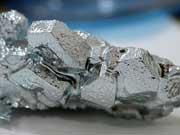Gallium fools iron-seeking bacteria
Antibiotic-resistant bacteria can be killed with gallium. US researchers used gallium as a ’Trojan horse’ to fool bacteria into thinking they were feeding on iron. Bacteria need iron to survive, but they cannot distinguish between iron and gallium. Gallium does not function like iron, so the bacteria died, regardless of their antibiotic resistance.
Antibiotic-resistant bacterial strains are a menace on hospital wards, in nursing homes, and for people with compromised immune systems. Common offenders, like Pseudomonas aeruginosa, live in polymer-reinforced colonies called biofilms, which block the action of the immune system and of antibiotics sent to deal with them.

Pradeep Singh, associate professor of microbiology at the University of Washington and colleagues, came up with a novel strategy. Rather than find new antibiotics, they intensified the stresses already faced by bacteria. For example, iron is critical for bacteria to grow and form biofilms. The mammalian immune system has evolved defence mechanisms that hide the iron from invading organisms. This involves white cells, called neutrophils, which secrete the iron-binding protein lactoferrin.
’The bacteria have to steal some iron from the host if they are to survive’ said Singh. ’Feeding them gallium which they mistake for iron, kills them and stops the formation of biofilms, even when they are antibiotic resistant.’
Many biological systems cannot distinguish Ga3+ from Fe3+ because they have virtually identical ionic radii. But gallium lacks iron’s vital redox chemistry driving cells’ metabolic processes. Mistaking gallium for iron is fatal to P. aeruginosa. Singh’s team also showed that gallium enhanced lactoferrin activity, and that bacterial mutation of P. aeruginosa’s iron uptake system did not induce gallium resistance.
Even better, gallium was shown to interfere with bacterial genes activated under conditions of iron starvation, further enhancing gallium’s antimicrobial activity. The system was tested on mice. Its activity in humans remains unknown although gallium was recently cleared by the US food and drug administration for post-cancer therapy high blood calcium levels.
If gallium mimics iron then it might be expected to stop cellular iron uptake and cause anaemia, leading to further infection. ’High doses of gallium do induce anaemia’, said Singh, ’but these are given to immuno-compromised cancer patients and there is no evidence of opportunistic infections.’
Lionel Milgrom
References
Y Kaneko, et al, J. Clin. Invest.,2007, DOI:10.1172/JCI30783






No comments yet